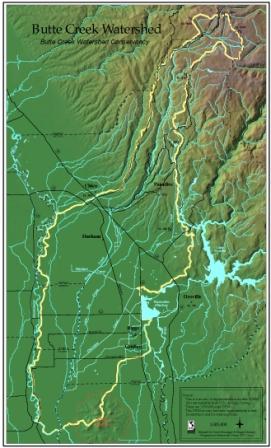|
|||||||
|
|
|||||||
| Watershed | |||||||
| Existing Conditions Report | Watershed | ||||||
|
Think of the journey of a drop of rain. Say a raindrop falls on top of a house in Paradise. The raindrop's journey ahead might look something like this. It comes down the gutter onto the ground and starts to form a little trickle behind your place. The trickle meets up with other trickles and becomes a little stream. Before long this stream flows into the Magalia Reservoir and then out into Little Butte Creek. Little Butte Creek makes its way down from the ridge and into the Butte Creek Canyon were it converges with Butte Creek. This means the house in Paradise, where the raindrops journey began, is in the Butte Creek Watershed! The Butte Creek Watershed encompasses approximately 510,000 acres and lies predominantly in Butte County with smaller portions in Tehama, Glenn, Colusa and Sutter Counties. The watershed is home to a diverse and significant populations of both plant and animal life. This plant and animal life along with the watershed’s various and considerable resources of water, farmland, timber, and recreational opportunities enrich the lives of both its residents and visitors.
The valley section of Butte Creek is divided by the Sutter Buttes, located in the center of the Sacramento Valley. The upper portion is approximately 45 miles in length extending from Highway 99 near Chico to the point where Butte Creek first enters the Sacramento River at the Butte Slough Outfall Gates southeast of Colusa. Historical records suggest that prior to levees being built along the Sacramento River, Butte Creek entered the River in this vicinity. Butte Creek in this reach is surrounded by agricultural lands, several state and federal wildlife areas, and is contained, at times, by a series of levees.
Butte Creek flows are regulated into the Sacramento River by the Butte Slough Outfall Gates to accommodate both flood flows and agricultural needs in the Sutter Bypass area. The Sutter Bypass section of Butte Creek is approximately 40 miles in length. Butte Creek (now Butte Slough) splits into two channels, known as the East and West Borrow Canals, as it enters the Sutter Bypass near Highway 20. Generally, Butte Creek enters the Sacramento River via Sacramento Slough immediately upstream of the mouth of the Feather River near Verona. |
|||||||
|
|
Copyright © 2007 Butte Creek Watershed Conservancy. All Rights Reserved. If you have any additional questions about the Butte Creek Watershed Conservancy or have comments regarding this site please email creek@buttecreekwatershed.org | ||||||


 Butte Creek, a major tributary to the Sacramento
River, originates in the Jonesville Basin,
Lassen National Forest, at an elevation of 7,087 feet. Several
small tributaries converge in the Butte Meadows Basin, an area
characterized by a series of wide meadows and repeating series of
pools and riffles. Butte Creek transitions from the Butte Meadows
area approximately 25 miles through a canyon to the point where it
enters the valley floor near Chico. Numerous small tributaries
and springs enter the creek in the canyon area.
Butte Creek, a major tributary to the Sacramento
River, originates in the Jonesville Basin,
Lassen National Forest, at an elevation of 7,087 feet. Several
small tributaries converge in the Butte Meadows Basin, an area
characterized by a series of wide meadows and repeating series of
pools and riffles. Butte Creek transitions from the Butte Meadows
area approximately 25 miles through a canyon to the point where it
enters the valley floor near Chico. Numerous small tributaries
and springs enter the creek in the canyon area.  The reach of Butte Creek from Centerville
downstream is a productive Salmon fishery, attracting both the
endangered Spring-run Chinook and the Fall-run Chinook salmon.
Fall-run Chinook migrate upstream for spawning between the months of
October and December while Spring-run Chinook migrate between the
months of March and June. Juvenile salmon from both races rear
in Butte Creek from late winter through late spring en route to the
Pacific Ocean.
The reach of Butte Creek from Centerville
downstream is a productive Salmon fishery, attracting both the
endangered Spring-run Chinook and the Fall-run Chinook salmon.
Fall-run Chinook migrate upstream for spawning between the months of
October and December while Spring-run Chinook migrate between the
months of March and June. Juvenile salmon from both races rear
in Butte Creek from late winter through late spring en route to the
Pacific Ocean.